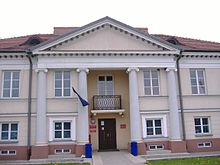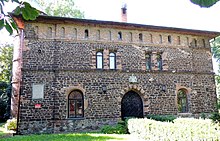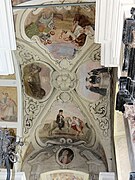Łowicz
Łowicz | |
|---|---|
 Cathedral in Łowicz | |
|
UTC+2 (CEST) | |
| Postal code | 99-400 to 99-402 |
| Area code | +48 46 |
| Vehicle registration | ELC |
| Website | www |
Łowicz
Łowicz was a residence of Polish
Łowicz has an important ethnographic museum (Muzeum w Łowiczu) exhibiting Polish art and historical artifacts from the region. Also, Łowicz features a popular skansen with traditional wooden houses. It is a vast open-air display of historical structures depicting traditional Polish village-life; a collection of artifacts spread over a 17-hectare (42 acre) site, just outside the town.[2]
Near the town is the
History
Middle Ages

The history of Lowicz dates back to the 12th century, when a
It is not known when Lowicz received town charter. First document which calls it oppidium (town) dates back to 1298, and was issued by Duke Boleslaw I of
In the late
Lowicz prospered in the 15th century. In 1404, Archbishop
On October 24, 1419, Archbishop Mikołaj Trąba confirmed the town charter of Łowicz and unified legal regulations of the three districts of Łowicz: Podgrodzie (Suburb), Stare Miasto (Old Town) and Nowe Miasto (New Town). In 1443, a town hall was built in the market square of the Old Town. Due to its convenient locations, multiple royal privileges and frequent fairs, Łowicz prospered. Administratively it was located in the Rawa Voivodeship in the Greater Poland Province.
Modern era

The town remained under the authority of the Archbishops of Gniezno, and as a residency of the Primates of Poland, since 1572 Łowicz occasionally served as a second capital of the Kingdom, during the periods known as

After the
In 1831, following the last will of Joanna Grudzinska, the Duchy of Lowicz became the property of Polish rulers. Since at that time Russian Tsars regarded themselves as Kings of Poland, the duchy belonged to them until World War I. Following the request of General Ivan Paskevich, who was the governor of Poland, Tsar Nicholas I of Russia gave permission for construction of the first railroad in the Russian Partition of Poland. The Warsaw–Vienna railway was completed in 1848, giving Łowicz rail connection with Warsaw, Kraków, Vienna and Wrocław. In 1861, Łowicz Główny railway station was built. Due to the construction of additional line to Koluszki (November 1866), Łowicz emerged as a rail hub, which contributed to its development. On July 26, 1863, during the January Uprising, a small Polish insurgent unit attacked the Russian troops stationed in the town, but soon withdrew.[9]
Following the
World War II

During the
In 1940, during the Nazi
During the Warsaw Uprising, in August–September 1944, the Germans deported several thousands of Varsovians from the Dulag 121 camp in Pruszków, where they were initially imprisoned, to Łowicz.[17] These Poles were mainly old people and women with children, many were sent to nearby villages, while over 3,400 stayed in the town as of mid-November 1944.[17]
Recent period
From 1975 to 1998, it was administratively located in
Points of interest
- Cathedral Basilica of the Assumption of the Blessed Virgin Mary, built in the first half of the 17th century by Italian architect Tomas Poncino. A former residential church of the archbishops of Gniezno and Primates of Poland, and burial place of a dozen archbishops of Gniezno and Primates of Poland.[18] Partially destroyed in 1939, the complex was rebuilt in 1949. It is listed as a Historic Monument of Poland,
- Baroque Piarist Church of Our Lady of Graces and Adalbert of Prague (1672–80), with a Rococo façade,
- Baroque Bernardine Church of the Immaculate Conception and Saint Elisabeth,
- former Evangelist church (1838–39), now an art gallery
- Neo-Gothic Mariavite Church (1910),
- Neoclassical town hall (1825–28), designed by Bonifacy Witkowski, with a plaque commemorating 5,808 inhabitants of Łowicz murdered by the Germans during World War II, and plaques commemorating visits of Tadeusz Kościuszko (in 1790) and Pope John Paul II (in 1999)
- Baroque complex of missionaries, built in the early 18th century by Tylman van Gameren, today housing the Museum in Łowicz
- Holy Spirit Church, built in the early 15th century in Gothic style, and rebuilt/remodelled several times,
- General Stanisław Klicki's Tower,
- monument to the Sons of Łowicz Land, Fighters for Polish Independence at the Rynek (market square),
- monuments to Józef Piłsudski, Tadeusz Kościuszko and Pope John Paul II,
- former Bernardine monastery, today a Pedagogical College,
- ruins of a Gothic castle of Primates of Poland, built in ca. 1355 by Archbishop Jaroslaw of Bogoria and Skotniki. The complex was ransacked and destroyed by Swedish invaders in 1655,
- Saxon Garden,
- house at Rynek 3, where Napoleon stayed in 1806, with a memorial plaque.
-
Interior of theCathedral Basilica
-
Piarist church
-
Town hall
-
Holy Spirit Church
-
Museum
-
Mariavite church
Sports
Łowicz has a football team called Pelikan Łowicz, who languish in the lower divisions of the Polish leagues, and Księżak Łowicz - basketball team.
Arts and Culture
The Encyclopedia of Cultures and Daily Life (1999) via Gale Research cited Lowicz, Poland as known for its rainbow-colored cloth as part of folk art throughout Poland which includes pottery, glass, regional costumes, and paper cutouts.[19]
Notable people

- Jerzy Jarniewicz (born 1958), poet, literary critic, translator and essayist, winner of 2022 Nike Award
- Stanisław Klicki (1775–1847), Polish general and aristocrat, participant of the Kościuszko and November Uprisings
- Daniel Olbrychski (born 1945), film and theatre actor
- Mirosław Szonert (1926–1995), film and television actor
- Jeanne Pratt (born 1936), Australian philanthropist and businesswoman, wife of Richard Pratt
- Przemysław Płacheta (born 1998), Polish professional football player
- Gedaliah Shaiak (1905-1983), Australian Yiddish language writer and journalist; editor of Jewish Post (Melbourne); contributor to memorial book about Jewish Lowicz; also artist
International relations
Twin towns — Sister cities
Łowicz is
- Cheektowaga, Erie County, NY, United States
 Colditz, Saxony, Germany
Colditz, Saxony, Germany
 Lubliniec, Silesian Voivodeship, Poland
Lubliniec, Silesian Voivodeship, Poland Montoire-sur-le-Loir, Loir-et-Cher, Centre-Val de Loire, France
Montoire-sur-le-Loir, Loir-et-Cher, Centre-Val de Loire, France
 Reda, Pomeranian Voivodeship, Poland
Reda, Pomeranian Voivodeship, Poland Šalčininkai, Lithuania
Šalčininkai, Lithuania
See also
- Agros Nova for information on the brand Łowicz and the factory
Notes and references
- ^ a b "Local Data Bank". Statistics Poland. Retrieved 26 August 2022. Data for territorial unit 1005011.
- ^ "Museum in Lowicz - The History and the Collections". Muzeum Łowicz. Archived from the original on 2008-05-05. Retrieved 2008-04-30.
- ^ Sapp, Mark E. (February 22, 2008). "Welding Timeline 1900-1950". WeldingHistory.org. Archived from the original on August 3, 2008. Retrieved 2008-04-29.
- ^ Kowalska-Urbankowa, Zofia (1985). "Jarosław ze Skotnik Bogoria, arcybiskup gnieźnieński, prawodawca i dyplomata (zm. 1376)". Nasza Przeszłość (in Polish). 63. Instytut Teologiczny Księży Misjonarzy: 73.
- ^ a b c d "Łowicz. O miejscowości". Turystyka.org.pl (in Polish). Retrieved 1 July 2020.
- ^ "Informacja historyczna". Dresden-Warszawa (in Polish). Retrieved 13 December 2020.
- ^ Gembarzewski, Bronisław (1925). Rodowody pułków polskich i oddziałów równorzędnych od r. 1717 do r. 1831 (in Polish). Warszawa: Towarzystwo Wiedzy Wojskowej. pp. 20, 26–29.
- ^ ISBN 83-88513-00-1.
- ^ Zieliński, Stanisław (1913). Bitwy i potyczki 1863-1864. Na podstawie materyałów drukowanych i rękopiśmiennych Muzeum Narodowego w Rapperswilu (in Polish). Rapperswil: Fundusz Wydawniczy Muzeum Narodowego w Rapperswilu. p. 39.
- Museum of the History of the Polish Jews (in English), as well as "Getta Żydowskie," by Gedeon, (in Polish) and "Ghetto List" by Michael Peters at www.deathcamps.org/occupation/ghettolist.htm (in English). Accessed July 12, 2011.
- ^ "The War Against The Jews." The Holocaust Chronicle, 2009. Chicago, Il. Accessed June 21, 2011.
- Instytut Adama Mickiewicza. (in Polish)
- ^ Warsaw Ghetto, United States Holocaust Memorial Museum (USHMM), Washington, D.C.
- ^ Richard C. Lukas, Out of the Inferno: Poles Remember the Holocaust, University Press of Kentucky 1989 - 201 pages. Page 13; also in Richard C. Lukas, The Forgotten Holocaust: The Poles Under German Occupation, 1939-1944, University Press of Kentucky, 1986, Google Print, p.13.
- ^ Gunnar S. Paulsson, "The Rescue of Jews by Non-Jews in Nazi-Occupied Poland," Journal of Holocaust Education, Vol.7, Nos.1&2, 1998, pp.19-44. Published by Frank Cass, London.
- ^ Edward Victor, "Ghettos and Other Jewish Communities." Judaica Philatelic. Accessed June 20, 2011.
- ^ a b "Warszawiacy na terenie powiatu łowickiego". Muzeum Dulag 121 (in Polish). Retrieved 13 December 2020.
- ^ a b Rozporządzenie Prezydenta Rzeczypospolitej Polskiej z dnia 22 października 2012 r. w sprawie uznania za pomnik historii "Łowicz - Bazylika Katedralna (dawna Kolegiata Prymasowska) pod wezwaniem Wniebowzięcia Najświętszej Marii Panny"., Dz. U. z 2012 r. poz. 1239
- ^ Gale, Timothy L. (Ed). (1997). The Encyclopedia of Cultures and Daily Life. Volume 4: Europe. Detroit, Michigan: Gale Research.







